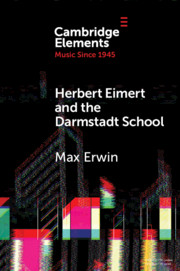Element contents
Herbert Eimert and the Darmstadt School
Published online by Cambridge University Press: 09 November 2020
Summary
- Type
- Element
- Information
- Series: Elements in Music since 1945Online ISBN: 9781108891691Publisher: Cambridge University PressPrint publication: 03 December 2020
Bibliography
- 11
- Cited by



